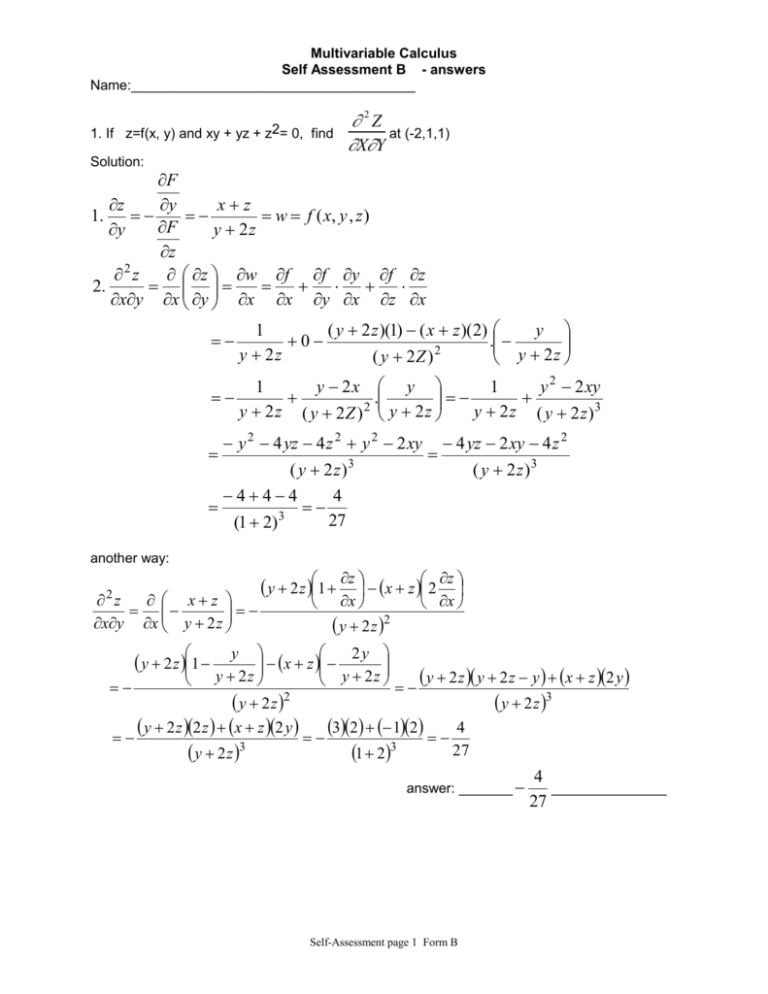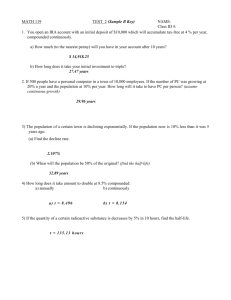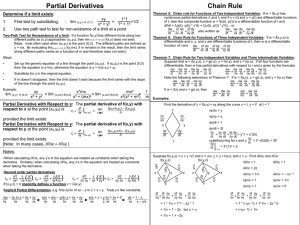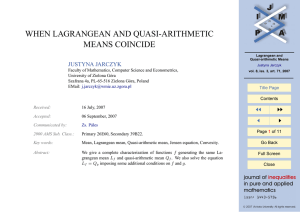Calculus III Self Assessment B Exam 3 Chapter 14 Sanchez 97:3,4
advertisement

Multivariable Calculus Self Assessment B - answers Name:_____________________________________ 1. If z=f(x, y) and xy + yz + z2= 0, find 2Z at (-2,1,1) XY Solution: F z xz y 1. w f ( x, y , z ) F y y 2z z 2 z z w f f y f z 2. xy x y x x y x z x 1 ( y 2 z )(1) ( x z )( 2) y 0 . y 2 z y 2z ( y 2Z ) 2 1 y 2x y 1 y 2 2 xy . y 2 z ( y 2Z ) 2 y 2 z y 2 z ( y 2 z)3 y 2 4 yz 4 z 2 y 2 2 xy ( y 2 z)3 444 4 27 (1 2) 3 4 yz 2 xy 4 z 2 ( y 2 z )3 another way: z xz xy x y 2 z 2 y 2 z 1 z x z 2 z x y 2 z 2 x y 2y x z y 2z y 2 z y 2 z y 2 z y x z 2 y y 2 z 2 y 2 z 3 y 2 z 2 z x z 2 y 32 12 4 27 y 2 z 3 1 23 y 2 z 1 answer: _______ Self-Assessment page 1 Form B 4 _______________ 27 2. Use the Jacobian to find dy at (1, -1, 1) if dx -2xy + 3z + x2= 6 and 2x - y2 + yz = 2 Solution: 2 y 2x 3 ( F , G) 2 y dy ( x, z ) ( F , G) 2x 3 dx ( y, z ) 2y z y 4 3 2 1 10 10 2 3 7 7 3 answer: 10 7 1 3. Find the directional derivative of w= 2x2yz in the direction of v=3i-4j at he point (-1, 1, 3, 6) Solution : The gradient is given by : w 4 xyzi 2 x 2 zj 2 x 2 yk 12i 6 j 2k 3 4 The unit vector in the direction of v is u i j 0k 5 5 60 36 24 Dv w w u 0 12 answer : 12 5 5 5 4. Use the Lagrangean coefficients technique to find the minimum value of subject to the condition w y z 2x 2 x y2 z 2. We want to find the minimum value of w y z 2x 2 for point located in the paraboloid x y2 z 2. Solution: using Lagrangean coefficients. F ( x, y , z , ) y z 2 x 2 ( x y 2 z 2 ) The lagrangean equation is given by F x 4 x 0 x 4 F 1 1 2 y 0 y y 2 F 1 1 2 z 0 z 2 z 1 1 F 2 2 3 3 x y z 0 4 2 2 0 2 2 4 4 Therefore, 2 3 2 1 3 4 3 4 3 4 33 4 w y z 2 x 3 3 2 3 4 2 8 8 2 2 2 2 2 8 2 answer: ___ 1 1 33 4 _______________ 8 Self-Assessment page 2 Form B 5. Find all critical points of f(x, y) = y3 + xy2 -2xy . Determine whether each critical point yields a relative maximum value, a relative minimum, or a saddle point. Step 1. f 2 x y 2 y 0 y ( y 2) 0 y 0 and x 0 or 2 f y 2 and 2 x 12 0 x 6 3 y 2 2 xy 2 x 0 3 y 2 xy 2 x 0 y Critical Points: The critical points are (0, 0, 0) and (-6, 2, 8) Step 2. 2 f 2 0 x 2 f at x 0 and y 0 2 0 4, saddle po int 2 f y 2 0 2 f x 2 2 f yx 2 6 y 2x 2 f y 2 0 2 f x 2y 2 2 yx at x 6 and y 2 f 2 4, saddle po int 2 y 2 f 2 y x Answer: both (0, 0, 0) and (-6, 2, 8) are saddle points 6) An ice cone is melting in such a way that the radius is decreasing at the rate of 2 inches per minute and the height is decreasing at the rate of 3 inches per minute. At what rate is the volume changing when r=3 feet and h=5 feet. 1 V V dr V dh V 2 1 V r 2h rh 2 r 2 3 3 t r dt h dt t 3 3 V 2 1 . (36)(60) 2 (36) 2 3 2880 1296 t 3 3 V 4176 sq inches per min 29 sq ft per min 91.106 ft min t answer: ______ 91.106 Self-Assessment page 3 Form B ft min _______ 7. If z = x2 +y2 , x=r+2s and y = 3r +s, find 2z r s Solution: z z x z y 2x 2 2 y 1 4x 2 y w s x s y s 2z w x w y ( w) 41 2(3) 10 rs r x r y r answer: __ 10________ 8. If f(x, y) = x2 -xy + y2 find 2z x y Solution: 2 z z x 2 y 1 x y x y x answer:____-1 ______ 9. If x=f(y, z), 4 = x3 -y3 -z3 , find x y y2 answer: : ___ _____ x2 Solution: F x 3y2 y2 y 2 F y 3x 2 x x 3 10. Use differentials to approximate 36.3 7.6 Solution: Let f ( x, y) x 3 y , x 36, x 0.3, f (36, 8) 36 3 8 12 y 8, y 0.4 3 y f f x x y x y 3 2 x y 2 x 3 x 2 6 6 24 18 3 0.3 0.4 0.15 12 12 120 120 120 20 Therefore, 36.3 3 7.6 12 0.15 11.85 answer : 11.85 f df Self-Assessment page 4 Form B 11. Find the maximum value of w= x2 +3y2 +2z2 subject to the condition 2x-3y+5z=1. Solution: using Lagrangean coefficients. 2 2 2 The lagrangean equation is given by F ( x, y , z , ) x 3 y 2 z ( 2 x 3 y 5 z 1) F x F y F z F 4 39 4 1 39 4 6 y 3 0 y x 2 39 2 5 y 4 z 5 0 z 39 4 5 3 25 z 2 x 3 y 5 z 1 0 2 1 0 39 2 4 16 12 50 78 2 Therefore, w x 2 3 y 2 2 z 2 2 2 2 2 answer 39 39 39 39 39 2 x 2 0 x 12. Find the point on the plane 2x-y +3z -5 =0 that is closest to the origin. Solution: We want to minimize d x 2 y 2 z 2 or D d 2 x 2 y 2 z 2 subject to the constraint that 2x - y + 3z -5 =0. The lagrangean equation is given by F ( x, y, z , ) x 2 y 2 z 2 (2 x y 3z 5) F 5 2 x 2 0 x 14 10 x 7 F 5 2y 0 y x y 2 7 5 F 3 y 2 z 3 0 z 14 z 2 15 F 1 9 z 2 x y 3z 5 0 2 5 0 14 2 2 5 15 5 Therefore, the closest po int is , , 7 14 14 Self-Assessment page 5 Form B 13. The gradient is normal to the level surface F(x, y, z) =0. It is because of this normality of the gradient that the maximum directional derivative ( which is ) at a point is often called the normal derivative at Normal Derivative at that point. We use the notation df dn for the normal derivative of a function f. Find the normal derivative of z = x3 y at the point (-1, 2, 2) and the corresponding unit vector. Solution: z 3x 2 yi x 3 j 6i j df z 6 2 (1) 2 37 dn 6 1 u i j 37 37 14. Show that lim x0 y 0 lim x0 y0 x2y x 4 y2 0 along any line y=mx, for any m. What is x2y x4 along y=x2 . Does lim 2 x0 y y 0 x2y x 4 y2 exist?. Explain. Solution: y mx, m 0 lim x 0 y 0 x2 y x4 y2 m 0 y 0 and lim y x lim x2 y x 0 y 0 x2 y x 0 y 0 2 lim x4 y2 lim mx3 x4 m2 x2 lim x 0 y 0 x4 0 x4 lim x 0 y 0 0 1 2 x 0 x 4 y 2 x 0 x 4 x 4 y 0 y 0 Therefore the limit does not exist because it is not unique Self-Assessment page 6 Form B mx x2 m2 0 m2 0









